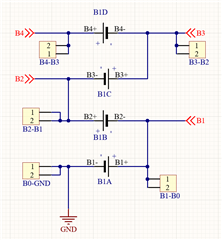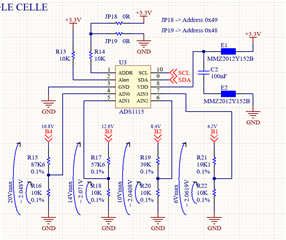Other Parts Discussed in Thread: ADS1119
Tool/software:
Hi everyone.
I'm looking for a simple to use chip that allows me to read only the precise voltages of 4 lithium batteries in series with each other (in 4S configuration as shown in the image)

I'm looking for a high precision ADC that allows me to only take voltage readings on 4 lithium cells placed in series (in 4S configuration as shown in the image) and that communicates with the ESP32 through the i2c protocol.
It is difficult to find a chip that only does what I require (for example, I have seen that these functions are present in battery charging chips, but since they are already in an advanced stage of the project it would mean having to start from the beginning with a good part of the work); so it could be that what you suggest also has other features, but if there was something that was limited to just doing what I need it would be excellent because the size and complexity of the package would be reduced.
I have now tried with an ADS1115 module which is 16bit, the problem is that its use to read the battery voltages is necessarily linked to voltage dividers and for other factors I need the Battery- to coincide with the GND of the whole rest of the system.
Currently the ADS1115 that I use is composed as follows but, I think due to the dividers (although all resistors are 0.1%) the voltage readings are not so precise compared to those read on the voltmeter (for example 16.72V on the voltmeter appears to be on the 'ADS1115 16.56V) and this with lithium battery is not a good thing as they are batteries for which you have to be careful of the voltages involved.

Do you have any other suggestions for getting the 4 accurate battery measurements?
Thank you
Gaggero





